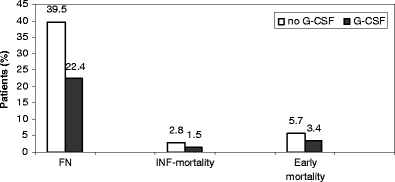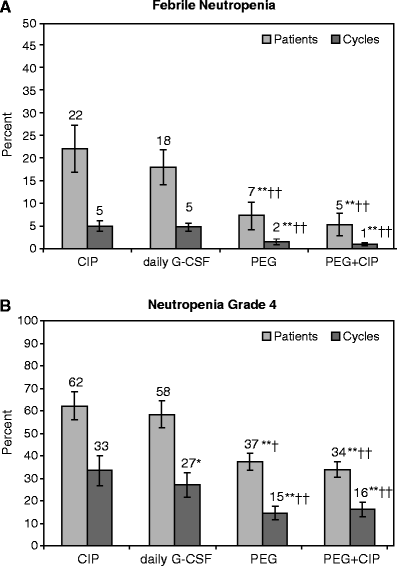Prophylaxis of chemotherapy-induced febrile neutropenia with granulocyte colony-stimulating factors: where are we now?
- PMID: 20191292
- PMCID: PMC2846279
- DOI: 10.1007/s00520-010-0816-y
Prophylaxis of chemotherapy-induced febrile neutropenia with granulocyte colony-stimulating factors: where are we now?
Abstract
Updated international guidelines published in 2006 have broadened the scope for the use of granulocyte colony-stimulating factor (G-CSF) in supporting delivery of myelosuppressive chemotherapy. G-CSF prophylaxis is now recommended when the overall risk of febrile neutropenia (FN) due to regimen and individual patient factors is >or=20%, for supporting dose-dense and dose-intense chemotherapy and to help maintain dose density where dose reductions have been shown to compromise outcomes. Indeed, there is now a large body of evidence for the efficacy of G-CSFs in supporting dose-dense chemotherapy. Predictive tools that can help target those patients who are most at risk of FN are now becoming available. Recent analyses have shown that, by reducing the risk of FN and chemotherapy dose delays and reductions, G-CSF prophylaxis can potentially enhance survival benefits in patients receiving chemotherapy in curative settings. Accumulating data from 'real-world' clinical practice settings indicate that patients often receive abbreviated courses of daily G-CSF and consequently obtain a reduced level of FN protection. A single dose of PEGylated G-CSF (pegfilgrastim) may provide a more effective, as well as a more convenient, alternative to daily G-CSF. Prospective studies are needed to validate the importance of delivering the full dose intensity of standard chemotherapy regimens, with G-CSF support where appropriate, across a range of settings. These studies should also incorporate prospective evaluation of risk stratification for neutropenia and its complications.
Figures




Similar articles
-
2010 update of EORTC guidelines for the use of granulocyte-colony stimulating factor to reduce the incidence of chemotherapy-induced febrile neutropenia in adult patients with lymphoproliferative disorders and solid tumours.Eur J Cancer. 2011 Jan;47(1):8-32. doi: 10.1016/j.ejca.2010.10.013. Epub 2010 Nov 20. Eur J Cancer. 2011. PMID: 21095116
-
Colony-stimulating factors for the management of neutropenia in cancer patients.Drugs. 2002;62 Suppl 1:1-15. doi: 10.2165/00003495-200262001-00001. Drugs. 2002. PMID: 12479591 Review.
-
Lecture: management of chemotherapy-induced febrile neutropenia; guidelines and colony stimulating factors.Neurol Sci. 2011 Nov;32 Suppl 2:S217-9. doi: 10.1007/s10072-011-0795-x. Neurol Sci. 2011. PMID: 22002072
-
Use of granulocyte colony-stimulating factor (G-CSF) in patients receiving myelosuppressive chemotherapy for the treatment of cancer. Provincial Systemic Treatment Disease Site Group.Cancer Prev Control. 1998 Aug;2(4):179-90. Cancer Prev Control. 1998. PMID: 10093631 Clinical Trial.
-
Implications of the European Organisation for Research And Treatment Of Cancer (EORTC) guidelines on the use of granulocyte colony-stimulating factor (G-CSF) for lymphoma care.Clin Drug Investig. 2009;29(8):491-513. doi: 10.2165/00044011-200929080-00001. Clin Drug Investig. 2009. PMID: 19591512 Review.
Cited by
-
A non-interventional study of biosimilar granulocyte colony-stimulating factor as prophylaxis for chemotherapy-induced neutropenia in a community oncology centre.Ther Adv Med Oncol. 2012 Nov;4(6):289-93. doi: 10.1177/1758834012461330. Ther Adv Med Oncol. 2012. PMID: 23118804 Free PMC article.
-
Incidence of febrile neutropenia during chemotherapy among patients with nonmyeloid cancer receiving filgrastim vs a filgrastim biosimilar.Clinicoecon Outcomes Res. 2018 Sep 3;10:493-500. doi: 10.2147/CEOR.S168298. eCollection 2018. Clinicoecon Outcomes Res. 2018. PMID: 30214262 Free PMC article.
-
Model-based approach to early predict prolonged high grade neutropenia in carboplatin-treated patients and guide G-CSF prophylactic treatment.Pharm Res. 2015 Feb;32(2):654-64. doi: 10.1007/s11095-014-1493-1. Epub 2014 Sep 4. Pharm Res. 2015. PMID: 25186439
-
Reliable, accurate determination of the leukocyte differential of leukopenic samples by using Hematoflow method.Korean J Lab Med. 2011 Jul;31(3):131-7. doi: 10.3343/kjlm.2011.31.3.131. Epub 2011 Jun 28. Korean J Lab Med. 2011. PMID: 21779183 Free PMC article.
-
Feasibility and safety of a reduced duration of therapy of colony-stimulating factor in a dose-dense regimen.Support Care Cancer. 2014 Sep;22(9):2557-61. doi: 10.1007/s00520-014-2237-9. Epub 2014 Apr 17. Support Care Cancer. 2014. PMID: 24740178 Free PMC article. Clinical Trial.
References
-
- Caggiano V, Weiss RV, Rickert TS, Linde-Zwirble WT. Incidence, cost, and mortality of neutropenia hospitalization associated with chemotherapy. Cancer. 2005;103:1916–1924. - PubMed
-
- Courtney DM, Aldeen AZ, Gorman SM, Handler JA, Trifilio SM, Parada JP, Yarnold PR, Bennett CL. Cancer-associated neutropenic fever: clinical outcome and economic costs of emergency department care. Oncologist. 2007;12:1019–1026. - PubMed
-
- Kuderer NM, Dale DC, Crawford J, Cosler LE, Lyman GH. Mortality, morbidity, and cost associated with febrile neutropenia in adult cancer patients. Cancer. 2006;106:2258–2266. - PubMed
-
- Mayordomo JI, Castellanos J, Pernas S, Ruiz-Borrego M, Velasco A, Frau A, Lamas MJ, Lara N, Gasquet JA, Sánchez J. Cost analysis of febrile neutropenia management of breast cancer patients in clinical practice in Spain. Ann Oncol. 2006;17(Suppl 9):ix190–ix195.
-
- Elting LS, Lu C, Escalante CP, Giordano SH, Trent JC, Cooksley C, Avritscher EB, Shih YC, Ensor J, Bekele BN, Gralla RJ, Talcott JA, Rolston K. Outcomes and cost of outpatient or inpatient management of 712 patients with febrile neutropenia. J Clin Oncol. 2008;26:606–611. - PubMed
MeSH terms
Substances
LinkOut - more resources
Full Text Sources
Other Literature Sources
Medical
Miscellaneous

